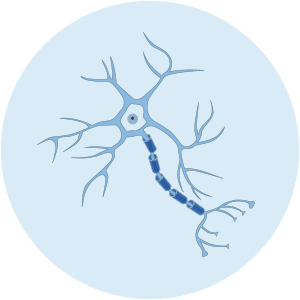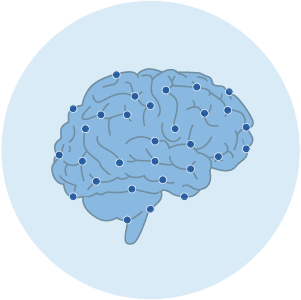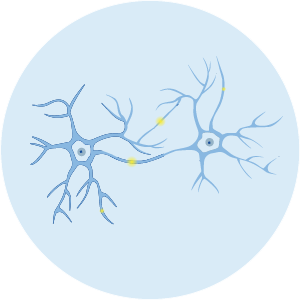Face-to-Face Curriculum
Overview
The BrainWaves curriculum consists of 2 units. Unit 1 is an instructional unit and is split into 3 modules, each with its own anchoring phenomenon. This unit is inquiry based and student-centered and takes approximately 5 to 6 weeks to complete. Unit 2 is devoted to student research using low-cost portable EEG devices and takes approximately 4 to 5 weeks to complete. In this unit, students experience the processes and practices of authentic research by working in small groups to carry out experiments and write scientific papers to share their findings.
Note: all lesson plans assume a period length of about 45 minutes.
Module 1: Neural Communication

In this module, students are introduced to the mechanisms of neural communication. Students will use a teenage double amputee named Tilly to answer the driving question: How can prosthetics be improved to compare to natural limbs? This module includes a hands-on learning experience during the SpikerBox lab, courtesy of Backyard Brains, in lesson 3. By the end of the module, students will be able to explain how neurons communicate including the role of electricity in action potentials and the role of neurotransmitters in communication between neurons.
1. How do neuroprosthetics work?
In this lesson, students will be introduced to the module 1 phenomenon, Tilly’s prosthetic arms. Students will watch a video about a teenager named Tilly who wears prosthetics on both arms. In the video, Tilly shares how she does her makeup with her prosthetic arms. Students will be asked to complete a notice and wonder chart then share questions they have with the class. As a pre-assessment, students will share what they already know about neuroscience by modeling their ideas about how prosthetic arms work. The class will then reflect on their existing conceptions of neuroscience through a Kahoot challenge on neuromyths. Throughout the module, students will work toward answering the driving question: How can prosthetics be improved to compare to natural limbs?
| View in New Tab Copy to Google Drive |
View in New Tab Copy to Google Drive |
2. What is neuroscience?
Students will begin by brainstorming ways they see neuroscience in everyday life. As a class, they will then develop a working definition of neuroscience and return to their questions from the previous lesson. Students will use their questions to begin thinking about experimental questions. Lastly, students will complete an activity related to independent and dependent variables.
| View in New Tab Copy to Google Drive |
View in New Tab Copy to Google Drive |
3. How does the brain communicate with the body?
Students will conduct an exploration of the role of electricity in neural communication. In this exploration, students will record electrical signals from neurons in a cockroach leg. They will work in groups to: (1) observe electrical signals in response to sensory stimulation (touching the leg); (2) trigger leg movement using electrical stimulation. By the end, students should discover the role electricity plays in communicating with our brain and apply their learning to Tilly’s prosthetic arms.
| View in New Tab Copy to Google Drive |
View in New Tab Copy to Google Drive |
4. What are the different parts of a neuron?
Students will begin by reflecting on their learning from the SpikerBox lab. They will then learn about the main parts of a neuron and how neurons communicate through small group research. Lastly, students will learn about different types of neurons and the functions of each one.
| View in New Tab Copy to Google Drive |
View in New Tab Copy to Google Drive |
5. How is a message sent from one end of a neuron to the other end?
Students will review the parts of a neuron and how neurons communicate through a brief video followed by direct instruction regarding action potentials. Students will learn how a message is sent from the dendrites to the axon terminals within a neuron. After learning the general principles of action potentials, groups are presented with a case study (Multiple Sclerosis or Alzhiemers) where students investigate and provide neurological explanations for subjects' behaviors. Lastly, students will apply their learning about action potentials and the relationship between neurons and behavior to make an initial hypothesis about the science behind prosthetics.
| View in New Tab Copy to Google Drive |
View in New Tab Copy to Google Drive |
6. How is a message sent from one neuron to another?
Students will learn how a message is sent from one neuron to another via neurotransmitters. Similar to the prior lesson, groups will put their knowledge to use by applying their understanding to different case studies to identify how drugs affect neurotransmission. By the end, students should describe the role neurotransmitters play in allowing communication between neurons.
| View in New Tab Copy to Google Drive |
View in New Tab Copy to Google Drive |
7. How can scientists make a direct link between prosthetics and the brain?
As a post-assessment, students will make revisions to their original model then construct a consensus model as a class. As an exit ticket, have students attempt a brief individual explanation to the module driving question: How can prosthetics be improved to compare to natural limbs? Responses in the exit ticket can be used to guide teachers in the next module in terms of what topics they may need to revisit before continuing with course.
| View in New Tab Copy to Google Drive |
View in New Tab Copy to Google Drive |
Module 1 Standards
Module 2: Brain Structure and Function

In this module, students will learn about brain structure and function. Students explore a case study of a 16 year old female patient with random onset of difficulty speaking and written communication. This module includes a dissection lab in which students dissect a sheep brain. By the end of the module, students will be able to explain the relationship between brain structure and function as well as the effect of brain damage on a person’s abilities and bodily function.
1. What happened to the patient and why?
In this lesson, students will be introduced to the anchoring phenomenon for module 2. This module will focus on a case study of a teenager who wakes up one morning with a type of aphasia known as dystextia, the inability to type coherent text. Students will use what they learned in module 1 and build on that knowledge to better understand what happened to the teen (the class can choose to give the patient a name to easily refer to her in future lessons).
| View in New Tab Copy to Google Drive |
View in New Tab Copy to Google Drive |
2. What are different parts of the brain?
Groups will explore a brain anatomy simulation to identify the different parts and functions of the brain. Students will also hypothesize how damage to different parts of the brain can affect different behaviors. Lastly, students will apply this knowledge to make inferences about the case study patient and their brain.
| View in New Tab Copy to Google Drive |
View in New Tab Copy to Google Drive |
3. What are the different parts of our brain and what do they do?
In this lesson, students will discuss the ethical concerns of using animals in science before engaging in dissection of a sheep brain. Groups will receive a real sheep brain and learn the procedures for conducting a dissection. Groups should pair their knowledge about the parts and functions of the brain with the observations of the real brain. Students will take pictures of the different parts of the brain as they dissect. By the end, students should know the proper dissection techniques, recognize the different lobes of a real brain and apply their learning to the dystextia patient.
| View in New Tab Copy to Google Drive |
View in New Tab Copy to Google Drive |
4. What happens if we damage our brain?
Students will use their existing knowledge of the brain to explore behavioral changes that occur upon injury to the brain. Students will work in groups to investigate the defects of brain damage through a number of classic neuroscience case studies (e.g. patient HM). Students will briefly discuss issues of equity in science research.
| View in New Tab Copy to Google Drive |
View in New Tab Copy to Google Drive |
5. What happened to the patient and why?
As a post-assessment, students will make revisions to their original model using a “Gotta Have List” (checklist of items to include in theri revisions). As an exit ticket, have students attempt a brief individual explanation to the module driving question: What happened to the patient and why? Responses in the exit ticket can be used to guide teachers in the next module in terms of what topics they may need to revisit before continuing with course content.
| View in New Tab Copy to Google Drive |
View in New Tab Copy to Google Drive |
Module 2 Standards
Module 3: Learning and Memory

In this module, students explore the processes of learning and memory. This module includes a unique anchoring phenomenon - the students’ own abilities! Students engage in a task called mirror tracing in which they attempt to trace an image based solely on the image’s reflection. Students collect data on their speed and accuracy performing the task and analyze how their data changes over time with repetition of the task. Throughout the module, students learn about the concept of neuroplasticity and explore how neural pathways can change due to different factors. At the end of the module, students begin working with the portable EEG devices needed for their research in unit 2.
1. How do we learn and remember?
In this lesson, students will complete a mirror tracing activity to experience learning and memory first hand. Students will collect data on their reaction times and tracing accuracy to analyze in the next lesson. Students will repeat the mirror tracing task three times and collect data to see changes over time. This activity will serve as the anchoring phenomenon (main focus) to be referenced repeatedly throughout this module.
| View in New Tab Copy to Google Drive |
View in New Tab Copy to Google Drive |
2. What is neuroplasticity?
Students will explore their own learning and memory through two games before repeating the mirror tracing task from the last lesson. Students will be introduced to the concept of neuroplasticity, the brain’s ability to change its pathways. Neuroplasticity will be discussed in more depth in the next lesson.
| View in New Tab Copy to Google Drive |
View in New Tab Copy to Google Drive |
3. How does neuroplasticity affect our brain?
Students will continue their learning about neuroplasticity in greater detail. Students will explore specific examples of neuroplasticity and work in small groups to describe the changes to the brain and how and why they occured. These examples will be discussed in order to improve student understanding of the concept. Lastly, students will revisit the mirror tracing activity one last time and begin constructing an explanation of their findings using their knowledge of neuroplasticity, learning and memory.
| View in New Tab Copy to Google Drive |
View in New Tab Copy to Google Drive |
4. What trends exist in the mirror tracing data and why?
Students will revise their initial explanations from the previous lessons to address the driving question: what trends exist in the mirror tracing data and why? To close, students will complete the fourth and final neuromyth kahoot. If time allows, teachers can lead the extension activity in which students complete the mirror tracing task with a new shape and compare their results to the star.
| View in New Tab Copy to Google Drive |
View in New Tab Copy to Google Drive |
5. What do your brain waves look like?
Students will learn how the field of neuroscience can test the different theories covered throughout the course thus far. Through the use of an EEG, students will see how their brain waves look in real-time, identify what affects their brainwaves, and see how they can use their brainwaves. First, the teacher will demonstrate use of the EEG before allowing students to engage with the devices themselves. In the next lesson, students will complete specific tasks using the EEGs and make observations.
| View in New Tab Copy to Google Drive |
View in New Tab Copy to Google Drive |
6. How can we conduct neuroscience experiments?
Students will undergo a range of different behavioral experiments (e.g. stroop). For each experiment, students will need to identify the different parts of the experimental designs, execute the experiment, and undergo data analysis to test their hypothesis. By the end, students should begin having ideas of how they can modify these different experiments to make it their own.
| View in New Tab Copy to Google Drive |
View in New Tab Copy to Google Drive |